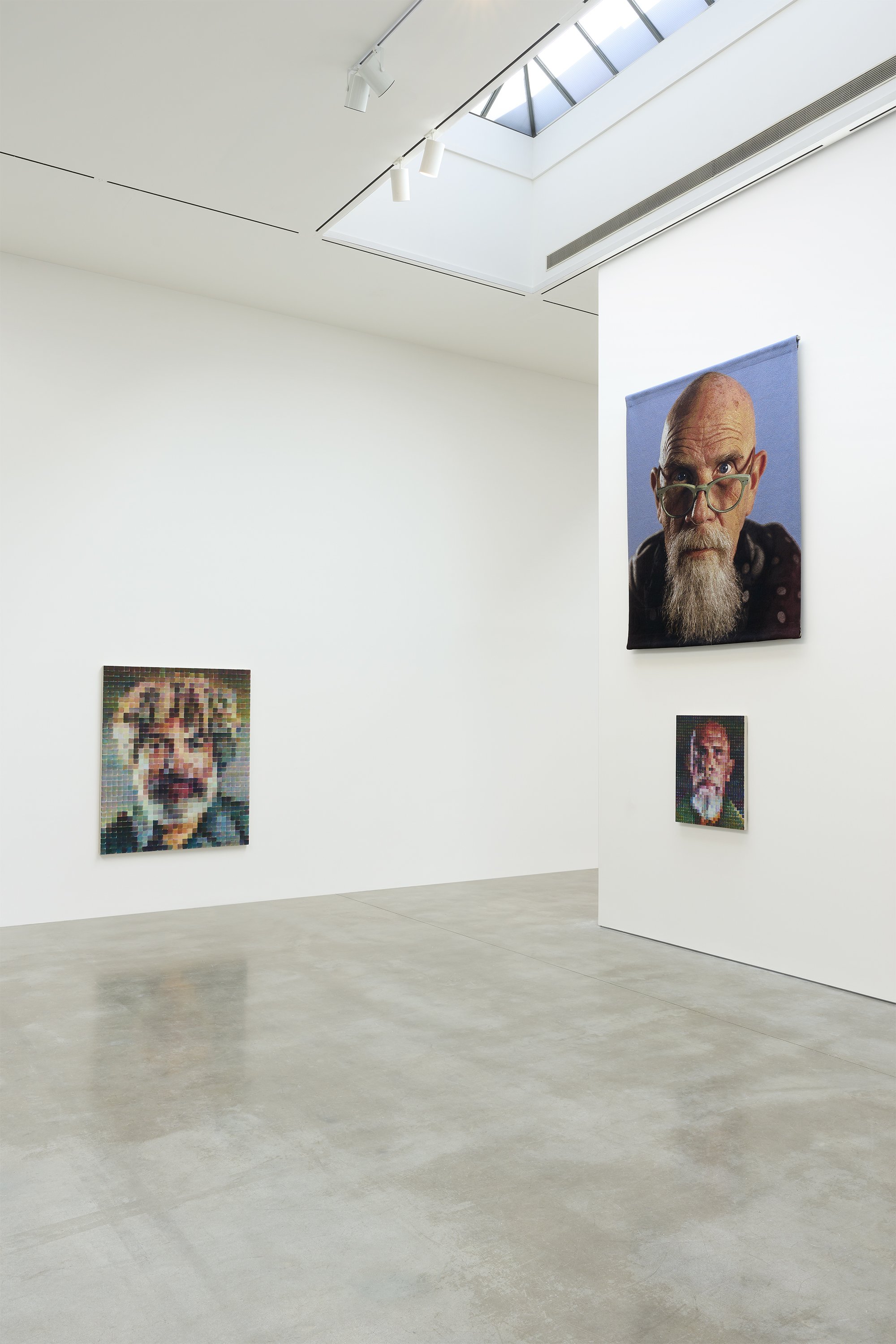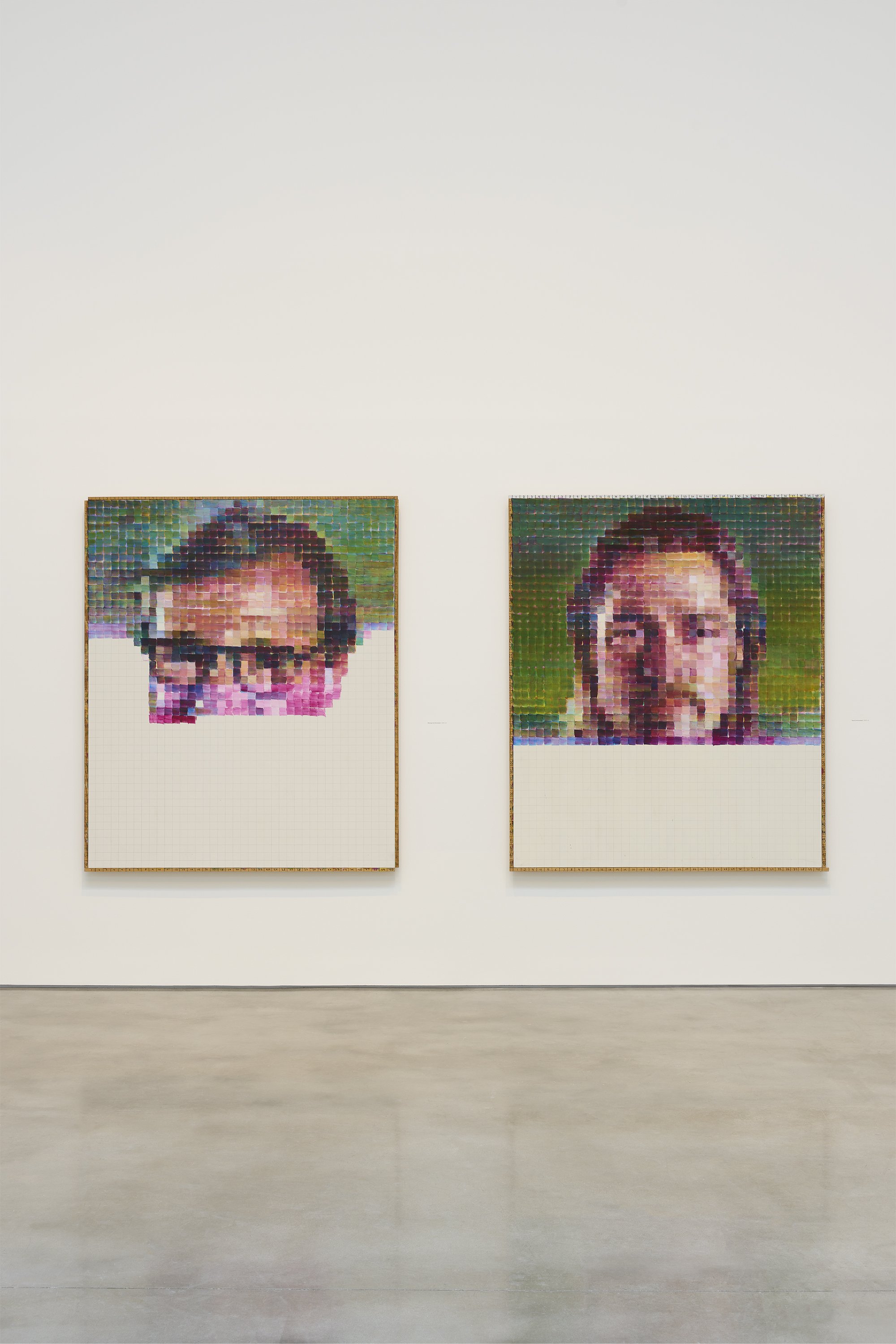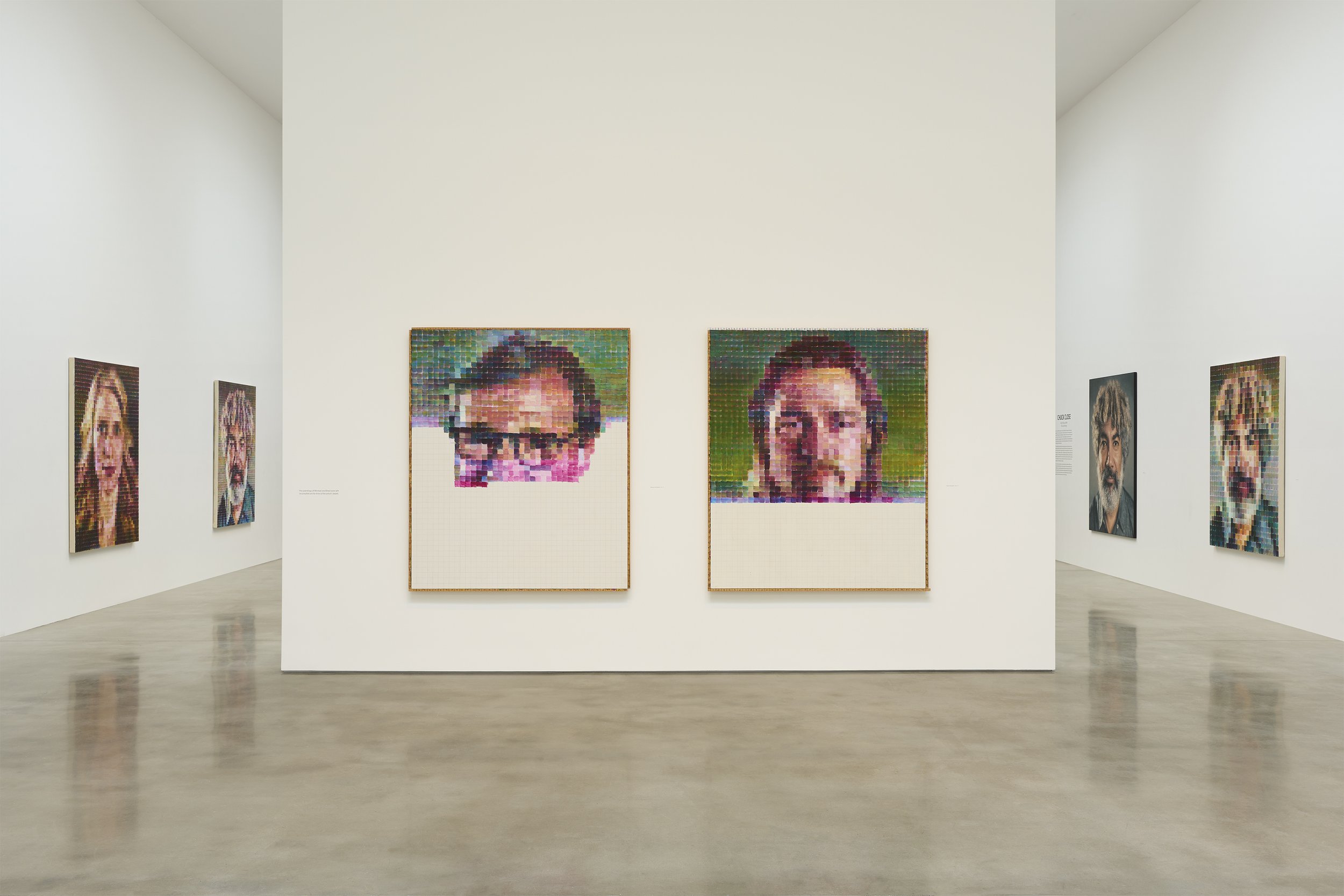Chuck Close : Red, Yellow and Blue: The Last Paintings
Fred/Diptych, 2017-2018 PAINTING oil on canvas 36" × 30" × 1-1/4" (91.4 cm × 76.2 cm × 3.2 cm), two panels, each No. 69339 © Chuck Close, courtesy Pace Gallery
New York – Pace is pleased to present an exhibition of the last paintings of Chuck Close at its 510 West 25th Street gallery in New York which opened on February 23 and will be on view until April 13, 2024. This is the gallery’s first presentation dedicated to the artist's work since his death in 2021; this show features a selection of paintings, photographs, and works on paper—most of which have never been exhibited before—that reflect Close’s significant contributions to the history of art. Since it began representing Close in 1977, Pace has exhibited each new body of his work, and this presentation will complete that cycle.
Brad, 2020-2021 PAINTING oil on canvas 36" × 30" (91.4 cm × 76.2 cm) No. 77931 ©Chuck Close, courtesy Pace Gallery
The exhibition is accompanied by a catalogue featuring a previously unpublished 2018 interview between Close and the artist Cindy Sherman—originally commissioned by The Brooklyn Rail—as well as a new critical essay by Carter Ratcliff, which considers Close’s final works in depth. These texts appear alongside an essay by Barbara Knappmeyer that examines the artist’s renderings of the face in the context of facial recognition technology.




Chuck Close, Red, Yellow and Blue: The Last Paintings 510 West 25th Street, New York, NY 10001 February 23 – April 13, 2024 Photography courtesy Pace Gallery
Since the 1970s, Close has been known for his innovative approach to conceptual portraiture, systematically transposing his subjects’ likenesses from photographs into gridded paintings. Over the course of five decades, his work challenged conventional modes of representation across a wide range of media, including various forms of painting, printmaking, drawing, collage, daguerreotypes, Polaroid photography, and tapestry.
Baby Jane, 2018-2019 PAINTING oil on canvas 102-1/2" × 84" (260.4 cm × 213.4 cm) No. 73510©Chuck Close, courtesy Pace Gallery
The artist posed a radical proposition with his approach to painting, going against the grain of art world trends during the late 1960s and 1970s, when Minimalism, abstraction, and seriality were dominant, and portraiture and photorealism were largely overlooked. Pace’s exhibition spotlights Close’s final body of paintings, which includes works that have never been publicly exhibited. These full-color portraits and self-portraits employ a palette of only three colors: red, yellow, and blue.
Claire, 2020 PAINTING oil on canvas 72" × 60" (182.9 cm × 152.4 cm) No. 77932 ©Chuck Close, courtesy Pace Gallery
Layering transparent glazes of paint, Close created an effect of abstract likeness entirely different from that of his previous work. The complex color relationships that unfold in these paintings are visible at the bleeding edges of each square within the grid, where the ragged ends of each individual color are visible. Meditating on the power of color itself, Close’s final works suggest the constructive aesthetics of Impressionism, where form is built up through a chromatic architecture of brushstrokes. Appearing more abstract than representational to the human eye, the likenesses in these portraits come into greater focus when viewed from a distance or through the lens of a camera, an act of transfiguration that speaks to the artist’s interest in modes of perception and information processing.
Close realized these formal achievements in his last works while grappling with long-term health issues precipitated by a spinal aneurysm that he suffered in 1988 at the age of 48. Having lost the use of his arms and legs as a result of the aneurysm, Close was told by doctors that he would never be able to paint again. Through a grueling process of rehabilitation, he eventually regained his ability to paint by using a brush-holding device strapped to his wrists and forearms. Working through this disability for the rest of his life, he was forced to teach himself how to paint in an entirely new way, reinventing his approach to the medium in the middle of his career. In his final works, Close continued to push against the constraints of his physical disability to reinvent his own painterly language once again.
Even prior to his aneurysm, however, Close struggled with other disabilities. Throughout his childhood and adolescence, he used art as a means of navigating severe dyslexia and prosopagnosia, or face blindness. Having studied at the University of Washington, Yale, and the Akademie der Bildenden Künste in Vienna, he began teaching at the University of Massachusetts, Amherst—where he would present his first solo exhibition—in the mid-1960s. Upon relocating to New York, the artist continued to explore new modes of realism, using an airbrush to paint blackand-white, highly detailed photographic portraits of himself, his family, and his friends onto large-scale canvases, a practice he would continue for the rest of his career. Close began in the late 1970s to make use of a grid system based on a physical relationship to his support. The resulting works read like pixelated mosaics wherein the viewer deciphers a unified image within juxtaposed colors, shapes, lines, and fingerprints. The artist’s first retrospective, titled Close Portraits, was organized by the Walker Art Center in Minneapolis in 1980. That show traveled to the St. Louis Art Museum in Missouri and the Museum of Contemporary Art Chicago before closing at the Whitney Museum of American Art in New York. In the early 1990s, he began experimenting with portraiture through the production of silk tapestries and, in 2003, he furthered this investigation, creating editions of large-scale Jacquard tapestry portraits. In 1998, the Museum of Modern Art in New York presented a full-scale retrospective of Close’s career that included more than 90 paintings, drawings, and photographs, cementing his status as one of the most influential artists of his generation.
Fred II, 2017 PAINTING oil on canvas 72"×60"×2"(182.9cm× 152.4 cm × 5.1 cm) No. 68273 © Chuck Close, courtesy Pace Gallery
Chuck Close’s (b. 1940, Monroe, Washington; d. 2021, New York) commitment to process and media characterized his approach to portraiture. He began creating portraits based on photographs in the late 1960s, using a grid to map each facial detail, which he would then recreate in exacting detail through painting. Beginning in the late 1970s,
Close began to diverge from his highly detailed approach, instead constructing images that are still organized by a grid, but with layers of autonomous shapes and colors that cohere into his subject’s face when viewed from a distance. Close constantly revitalized his practice through varied media and modes of representation and his oeuvre encompassed many modes of art-making, including painting, printmaking, drawing, collage, daguerreotype and Polaroid photography, mosaic, and tapestries.
Pace is a leading international art gallery representing some of the most influential contemporary artists and estates from the past century, holding decades-long relationships with Alexander Calder, Jean Dubuffet, Barbara Hepworth, Agnes Martin, Louise Nevelson, and Mark Rothko. Pace enjoys a unique U.S. heritage spanning East and West coasts through its early support of artists central to the Abstract Expressionist and Light and Space movements.
Since its founding by Arne Glimcher in 1960, Pace has developed a distinguished legacy as an artist-first gallery that mounts seminal historical and contemporary exhibitions. Under the current leadership of CEO Marc Glimcher, Pace continues to support its artists and share their visionary work with audiences worldwide by remaining at the forefront of innovation. Now in its seventh decade, the gallery advances its mission through a robust global program— comprising exhibitions, artist projects, public installations, institutional collaborations, performances, and interdisciplinary projects. Pace has a legacy in art bookmaking and has published over five hundred titles in close collaboration with artists, with a focus on original scholarship and on introducing new voices to the art historical canon.
Today, Pace has seven locations worldwide, including European footholds in London and Geneva as well as Berlin, where the gallery established an office in 2023. Pace maintains two galleries in New York—its headquarters at 540 West 25th Street, which welcomed almost 120,000 visitors and programmed 20 shows in its first six months, and an adjacent 8,000 sq. ft. exhibition space at 510 West 25th Street. Pace’s long and pioneering history in California includes a gallery in Palo Alto, which was open from 2016 to 2022. Pace’s engagement with Silicon Valley’s technology industry has had a lasting impact on the gallery at a global level, accelerating its initiatives connecting art and technology as well as its work with experiential artists. Pace consolidated its West Coast activity through its flagship in Los Angeles, which opened in 2022. Pace was one of the first international galleries to establish outposts in Asia, where it operates permanent gallery spaces in Hong Kong and Seoul, along with an office and viewing room in Beijing. In spring 2024, Pace will open its first gallery space in Japan in Tokyo’s new Azabudai Hills development.
For more information about this exhibition and others, please visit the Pace Gallery’s website here. Pace Gallery can be found on Instagram and Artsy, too.




